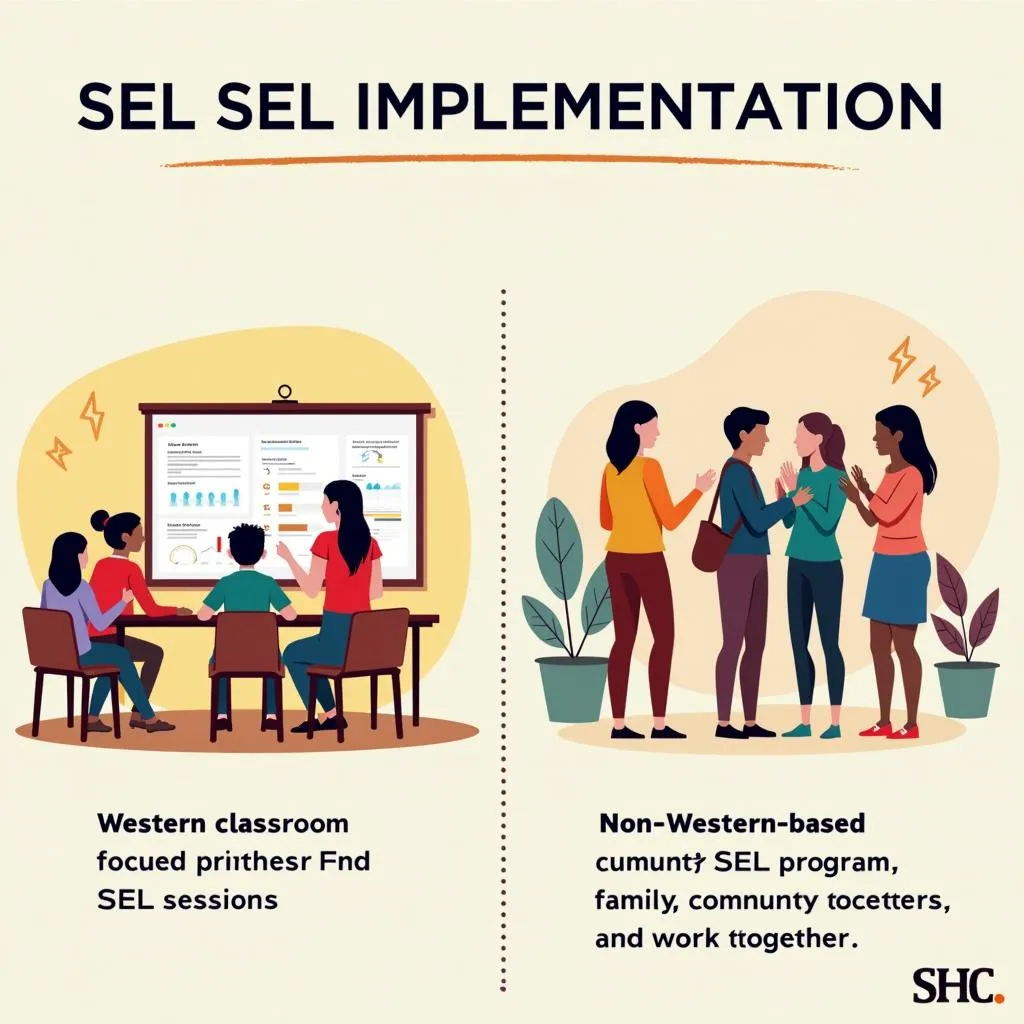Passage 1 – Easy Text
Social-emotional learning (SEL) has become an integral part of education systems worldwide. However, the development and implementation of SEL programs are not uniform across cultures. Cultural influences play a significant role in shaping how SEL is perceived, taught, and practiced in different societies.
In Western countries, SEL often focuses on individual growth, self-expression, and assertiveness. Children are encouraged to voice their opinions, express their emotions openly, and develop a strong sense of self. This approach aligns with the individualistic values prevalent in Western societies, where personal achievement and self-reliance are highly regarded.
Conversely, in many Eastern cultures, SEL takes on a different form. The emphasis is often placed on collective harmony, respect for authority, and emotional restraint. Children are taught to consider the needs of the group before their own, to show deference to elders, and to maintain composure in challenging situations. This approach reflects the collectivist values that are central to many Asian societies.
 Cultural influences on SEL: Western vs Eastern approaches
Cultural influences on SEL: Western vs Eastern approaches
The cultural context in which SEL is taught can have profound implications for its effectiveness and relevance. For instance, a SEL program developed in the United States may not be directly applicable in Japan without significant modifications to account for cultural differences. Understanding these cultural nuances is crucial for educators and policymakers seeking to implement effective SEL programs across diverse populations.
Passage 2 – Medium Text
The impact of cultural influences on social-emotional learning extends beyond the classroom and into the broader community. Research has shown that cultural factors shape not only the content of SEL programs but also the methods of delivery and assessment.
In individualistic cultures, SEL assessments often focus on measuring personal growth and individual achievements. Metrics such as self-esteem, self-efficacy, and personal goal-setting are commonly used to evaluate the success of SEL interventions. These measures align with the cultural emphasis on individual development and self-actualization.
Conversely, in collectivist cultures, SEL assessments may prioritize indicators of social harmony and group cohesion. Metrics such as prosocial behavior, conflict resolution skills, and adherence to social norms are often given greater weight. This reflects the cultural value placed on maintaining harmonious relationships and contributing to the well-being of the community.
The role of family and community in SEL also varies significantly across cultures. In many Western countries, SEL programs often focus on school-based interventions, with limited involvement from families or the broader community. This approach is rooted in the belief that schools are the primary agents of socialization outside the home.
However, in many non-Western cultures, the family and community play a much more central role in children’s social-emotional development. SEL programs in these contexts often involve extensive collaboration between schools, families, and community leaders. This holistic approach recognizes the interconnected nature of social-emotional development and the importance of cultural continuity between different spheres of a child’s life.
 Family and community involvement in SEL across cultures
Family and community involvement in SEL across cultures
The cultural differences in SEL approaches also extend to the specific skills and competencies that are prioritized. For example, in some Indigenous cultures, SEL may place a strong emphasis on connection to nature, spiritual well-being, and intergenerational learning. These aspects may be less prominent in mainstream Western SEL programs, which tend to focus more on individual emotional regulation and interpersonal skills.
Understanding these cultural variations is crucial for developing culturally responsive SEL programs that are effective and meaningful across diverse populations. It also highlights the need for ongoing research and collaboration between educators, researchers, and community leaders from different cultural backgrounds to create more inclusive and adaptable SEL frameworks.
Passage 3 – Hard Text
The intricate relationship between culture and social-emotional learning (SEL) is further complicated by the phenomenon of globalization and the increasing interconnectedness of societies worldwide. As cultures interact and influence one another, traditional boundaries blur, leading to the emergence of hybrid approaches to SEL that incorporate elements from various cultural traditions.
This cultural hybridization in SEL presents both opportunities and challenges. On one hand, it allows for the cross-pollination of ideas and practices, potentially leading to more comprehensive and nuanced approaches to social-emotional development. On the other hand, it raises questions about cultural authenticity and the potential loss of indigenous knowledge and practices.
The concept of cultural humility has gained traction in recent years as a guiding principle for developing and implementing SEL programs in diverse contexts. Cultural humility emphasizes the importance of ongoing self-reflection, recognition of one’s own cultural biases, and a commitment to lifelong learning about other cultures. This approach stands in contrast to the notion of cultural competence, which implies a finite set of knowledge and skills that can be mastered.
Adopting a cultural humility approach to SEL requires educators and policymakers to continuously engage with diverse communities, seeking to understand their unique perspectives, values, and needs. It also involves a willingness to adapt and modify SEL programs based on feedback and ongoing evaluation, rather than imposing a one-size-fits-all model.
The role of language in SEL is another critical factor that intersects with cultural influences. The linguistic structures and emotional vocabularies of different languages can significantly impact how social-emotional concepts are understood and expressed. For instance, some languages have more nuanced terms for describing emotional states than others, which can affect how emotions are perceived and regulated within that cultural context.
Moreover, in multilingual societies, the language of instruction for SEL programs can have profound implications for their effectiveness and inclusivity. Programs delivered in a dominant language may inadvertently marginalize students from linguistic minority groups, potentially exacerbating existing social and emotional challenges.
 Cultural humility in SEL implementation
Cultural humility in SEL implementation
The impact of historical and sociopolitical factors on SEL cannot be overstated. Societies that have experienced colonization, conflict, or significant social upheaval may approach social-emotional learning through a lens of healing and reconciliation. In these contexts, SEL programs may need to address intergenerational trauma, cultural revitalization, and the rebuilding of social trust.
Furthermore, the intersection of SEL with issues of social justice and equity adds another layer of complexity to its cultural implementation. SEL programs must be carefully designed to avoid perpetuating existing power imbalances or reinforcing harmful stereotypes. This requires a critical examination of the implicit cultural assumptions embedded in SEL frameworks and a commitment to promoting equity and inclusion.
As the field of SEL continues to evolve, there is a growing recognition of the need for more culturally sustaining approaches that not only acknowledge cultural differences but actively support and nurture diverse cultural identities. This shift represents a move away from deficit-based models that seek to “fix” perceived shortcomings in certain cultural approaches to SEL, towards asset-based models that celebrate and build upon the unique strengths of different cultural traditions.
In conclusion, the development of truly effective and inclusive SEL programs requires a nuanced understanding of the complex interplay between culture, language, history, and social dynamics. It calls for collaborative, interdisciplinary approaches that bring together insights from education, psychology, anthropology, and cultural studies. Only through such holistic and culturally responsive efforts can SEL fulfill its potential to support the social and emotional well-being of all learners in our increasingly diverse and interconnected world.
Questions
Passage 1 – Easy Text
-
According to the passage, how does the approach to SEL differ between Western and Eastern cultures?
A) Western cultures focus on individual growth, while Eastern cultures emphasize collective harmony
B) Eastern cultures prioritize self-expression, while Western cultures focus on emotional restraint
C) Both cultures have identical approaches to SEL
D) The passage does not mention any differences -
Which of the following is NOT mentioned as a characteristic of SEL in Eastern cultures?
A) Respect for authority
B) Emotional restraint
C) Consideration for group needs
D) Encouragement of self-expression -
The passage suggests that SEL programs developed in one culture may need to be ___ when implemented in another culture.
A) Ignored
B) Modified
C) Rejected
D) Simplified -
True/False/Not Given: Western SEL approaches encourage children to voice their opinions openly.
-
True/False/Not Given: Eastern cultures value individual achievement more than collective harmony in SEL.
-
True/False/Not Given: Cultural influences have no impact on the effectiveness of SEL programs.
Passage 2 – Medium Text
-
In individualistic cultures, SEL assessments often focus on measuring:
A) Group cohesion
B) Personal growth
C) Conflict resolution skills
D) Adherence to social norms -
Which of the following is mentioned as a metric used in collectivist cultures to assess SEL?
A) Self-esteem
B) Personal goal-setting
C) Prosocial behavior
D) Self-efficacy -
According to the passage, how does the involvement of family and community in SEL differ between Western and non-Western cultures?
A) Western cultures involve families more than non-Western cultures
B) Non-Western cultures often have more extensive collaboration between schools, families, and community leaders
C) Both cultures have identical approaches to family and community involvement
D) The passage does not mention any differences in family and community involvement -
Complete the sentence: In many Indigenous cultures, SEL may place a strong emphasis on , , and ___.
(Choose THREE answers from the list below)
A) Connection to nature
B) Spiritual well-being
C) Intergenerational learning
D) Individual emotional regulation
E) Interpersonal skills -
True/False/Not Given: Western SEL programs typically focus more on interpersonal skills than on emotional regulation.
-
True/False/Not Given: The passage suggests that cultural differences in SEL approaches are insignificant and can be easily overcome.
Passage 3 – Hard Text
-
What phenomenon does the passage identify as complicating the relationship between culture and SEL?
A) Urbanization
B) Globalization
C) Industrialization
D) Digitalization -
The concept of cultural humility in SEL emphasizes:
A) Mastering a finite set of cultural knowledge and skills
B) Imposing a one-size-fits-all model of SEL
C) Ongoing self-reflection and recognition of cultural biases
D) Avoiding engagement with diverse communities -
According to the passage, how can the language of instruction for SEL programs affect their effectiveness?
A) It has no impact on effectiveness
B) It can potentially marginalize students from linguistic minority groups
C) It always improves the effectiveness of SEL programs
D) The passage does not discuss the impact of language on SEL effectiveness -
Which of the following factors is NOT mentioned as influencing the cultural implementation of SEL?
A) Historical experiences of colonization
B) Sociopolitical factors
C) Economic development
D) Issues of social justice and equity -
The passage suggests a shift in SEL approaches towards:
A) Deficit-based models
B) Culturally sustaining approaches
C) Standardized global programs
D) Monolingual instruction -
Complete the sentence: The development of effective and inclusive SEL programs requires a nuanced understanding of the complex interplay between , , , and .
(Choose FOUR answers from the list below)
A) Culture
B) Language
C) History
D) Social dynamics
E) Technology
F) Economics
Answer Key
- A
- D
- B
- True
- False
- False
- B
- C
- B
- A, B, C
- Not Given
- False
- B
- C
- B
- C
- B
- A, B, C, D
This comprehensive IELTS Reading practice test covers various aspects of cultural influences on social-emotional learning. It provides valuable insights into how different cultures approach SEL and the challenges in implementing culturally responsive programs. For more information on related topics, you might find these articles helpful:
- Cultural Differences in Teacher-Student Relationships
- Cultural Differences in Early Childhood Education
- How Multiculturalism Shapes Modern Education Systems
Remember, understanding cultural nuances is crucial not only for SEL but also for success in the IELTS exam, where texts often explore cross-cultural themes. Keep practicing with diverse reading materials to improve your comprehension skills and expand your cultural knowledge.


